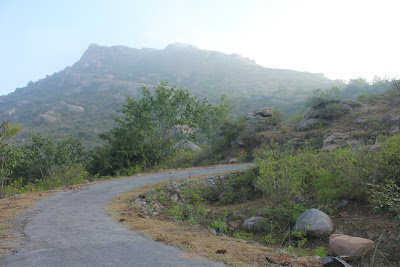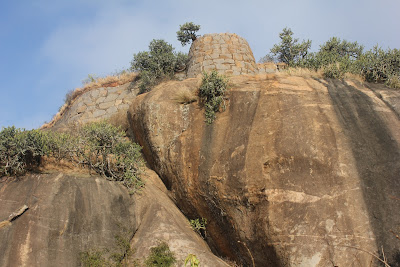Deepak, Gulveer and I left home quite early. My plan was to visit 3 forts for the day- Chennarayana Durga, Madhugiri and Midigeshi. I think as we passed Nelamangala we saw tiny raindrops in the windscreen. The drops got larger and after a while the wiper was on. Oh, what a day we chose to climb a rock hill! Never mind, the weather might change when the Sun is out ...we drove on.
Deepak was suddenly hungry when he saw Kamat near Dobbaspet. I was hoping to taste thatte-idli in one the small towns or any of the villages. Anyway, we had warm idlis and vade. At Dobbaspet we left NH4 to join s SH to Kortagere. As we drove deeper into the country side, weather was slightly different. We had dry patches in between bu weather was wet most places.
As we neared Madhugiri we could see the lower portion of the monolith, clouds covered the upper portion. At the town entrance a large billboard welcomed visitors. There it is- the only clear view of Madhugiribetta for the day.
Google Map screen-shot of the Madhugiri Betta. The hill is about 1200m length wise. Air distance between start and end points of our trek is about 800m. Going by Google Terrain, the hill is about 300m (984 feet.) high.
We are in the fort now, at the base of the hill. Deepak and Gulli are walking on the paved foot path.
Massive boulders connected by thick walls definitely kept out enemy forces.
A number of questions arise- how the engineers planned; how workers hauled heavy stones; how tools and implements were maintained; did kings take care of food for workers; medical care for injured workers; did work stop in rainy season?
We are looking at the North-eastern face of the hill.
Two doorways side by side.
Steps cut-out in rocks.
Another gateway. Roof slabs are missing leaving out the frame-work of columns and beams.
That's Madhugiri town. Going back in history, Venkataramana temple and Malleshvara temple would be noticeable easily.
Looking towards West ...that must be Siddapura Kere, also known as Baba's Lake.
Third gateway. Notice the smaller doorway to the left? Probably wooden doors were installed to secure the entrances.
A long way up to the top. This was one of the moments of less dense clouds around the hill top.
A turret cum watch tower to our left. I wonder why stones are left sticking out of the walls.
This must be Bheemana Dhone ~ Bheema Tank. According to the information on the board there's another tank named Navilu Dhone ~ Peacock Tank. I do not remember seeing Navilu Dhone.
Engineers have used this particular rock formation cleverly ...a secure turret to keep watch on the town below and the main entrance of the fort. The ramp leading up this turret is pretty steep. Perhaps a cannon was placed in the turret back then. A speck in the center of this picture is Gulli standing at the base of the ramp.
While Deepak and Gulli rest I explored the fortification walls on the south-eastern side. The little doorway straight ahead is entrance to Hanuman temple. The dome on the left must have been used to store food grains or oil.
Jai Hanuman. Every fort must have Hanuman, the God of strength.
This small doorway is the only exit in this side of the fort.
A watch tower ...typical Hyder-Tipu architecture. I wonder what's the purpose of that arch. Few cactus seen here are size of small trees. Weather was still same, no signs of clouds clearing away for the day.
A massive boulder we just passed by. I convey my thanks to the people who fixed these railings, it made climbing easy in wet weather.
In through another gateway and we look up to another gateway.
From this point on we could feel the wind ...Thane was blasting India's East coast.
I had to split the article into two parts; click Madhugiri fort - part two to continue.
.........






































































